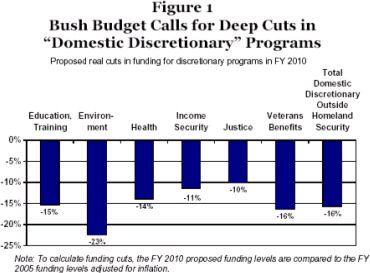| |
 February 11, 2005
WHAT IS — AND ISN'T — IN THE PRESIDENT'S BUDGET
The 2006 budget the White House released this week is a statement of the
Administration's priorities. The Administration is responding to continuing
high deficits not by reassessing any of the tax cuts that have contributed
substantially to the deficits, but solely through reductions in a wide array of
domestic programs. Indeed, the budget proposes new tax cuts, as well as making
existing tax cuts permanent.
As a result, the proposed
budget would not reduce the deficit at all from what it would be absent
the policy changes proposed by the Administration. The domestic program cuts
are more than outweighed by the proposed tax cuts and the defense and homeland
security spending increases in the budget. Tables in the Administration’s
budget show deficits would be $29 billion higher over the next five years
with the Administration’s budget proposals than without them. Beyond this
period, as the price of the tax cut proposals swells, the budget would greatly
increase the deficit.
See:
 Quick Overview:
Assessing President Bush's New Budget Proposal
Quick Overview:
Assessing President Bush's New Budget Proposal
 What the President's Budget Shows About the Administration's Priorities
What the President's Budget Shows About the Administration's Priorities
What Is in the Budget
- Substantial domestic program reductions overall. The
budget includes $214 billion over five years in cuts in domestic discretionary
programs (non-entitlement programs other than those in the Defense Department,
international affairs, or homeland security), with the cuts growing much larger
with each passing year and reaching $66 billion — or 16 percent — by 2010.
(Cuts are compared to the 2005 level, adjusted for inflation.) The budget would
lock in its cuts in discretionary programs through the enactment of caps on the
total amount that can be appropriated each year for these years.
See:


- Substantial
reductions to a wide range of program areas. The budget fails to provide
proposed funding levels for individual appropriated programs for years after
2006, the first time since 1989 that an Administration’s budget has lacked this
type of information. By examining unpublished backup budget documents provided
by OMB to the Budget Committees of Congress, however, one can see the cuts the
budget contains in 2007-2010 in various program areas. (As noted, the cuts in
these years are quite important, since the proposed discretionary spending caps
would lock in deep cuts in discretionary programs.) As Figure 1 shows, by 2010,
the cuts would reach 23%, or $8 billion, in environmental programs and national
parks, 14 percent (or $8 billion) in health research and services, and 16
percent (or $6 billion) in veterans’ services (including veterans’ health care),
to name a few.
- Low-income working families with children would be affected by
a number of the proposed cuts.
- approximately 300,000 people, primarily in low-income working
families, would lose food stamp benefits under the Administration’s proposed cut
in the food stamp program;
- 300,000 children would lose child care assistance in 2009 under
the Administration’s proposed five-year freeze in child care funding; and
- In addition, the proposed reduction of $45 billion over ten years
in federal funding for state Medicaid programs would likely lead to a number of
states to take actions that would increase the ranks of the uninsured and the
underinsured; low-income working families would likely be among those most
heavily affected.
- More tax cuts, along with a gimmick to help get them through
Congress. Lack of revenues is the main reason behind the rise in
deficits: revenues are now lower, as a share of the economy, than in any year
in the 1960s, the 1970s, the 1980s, or the 1990s. The Administration’s
budget would make its tax cuts permanent and add a number of new tax cuts on
top. In all, these tax cuts would cost $1.4 trillion over ten years
($1.6 trillion when the added interest payments on the debt are taken into
account).
What Isn’t in
the Budget
The budget conceals the fiscal effects of
Administration proposals that would increase the deficit, as well as the
consequences of various cuts in domestic programs it proposes.
Items omitted from the budget include:
- All costs of military operations in Iraq and Afghanistan and
the global war on terrorism, after the $80 billion the Administration has
requested for 2005 is exhausted. CBO estimates these additional costs could
total around $350 billion over the next ten years (excluding interest payments
on the debt), assuming an eventual phasedown of U.S. activities in Iraq and
Afghanistan.
- Any of the cost of the President’s proposal to divert Social
Security payroll taxes to establish private accounts. That plan would add
about $1.4 trillion to the debt over its first ten years (2009-2018) and about
$3.5 trillion more to the debt in the following ten years (2019-2028). The
White House has cited $750 billion in costs for an earlier ten-year period
(2006-2015), but that number is misleadingly low: the plan wouldn’t even begin
phasing in until 2009 and wouldn’t become fully effective until 2011.
- The cost of continuing relief from the alternative minimum tax
(AMT) after 2006. The President’s budget proposes extending the current
temporary AMT fix only for one year, through 2006. According to CBO, extending
AMT relief through 2015 could cost nearly $700 billion over ten years (excluding
interest).
Also absent from the budget are ways
to reduce the deficit that would produce a more even-handed approach to deficit
reduction. As one example, the budget could have offered to cancel or defer two
tax cuts enacted in 2001 that have not even begun to take effect yet. Some 97
percent of the tax cuts that these two provisions will provide will go to
households with incomes over $200,000. Eliminating these provisions would
reduce the deficit by close to $200 billion from 2010 to 2019.
See:


|
|
